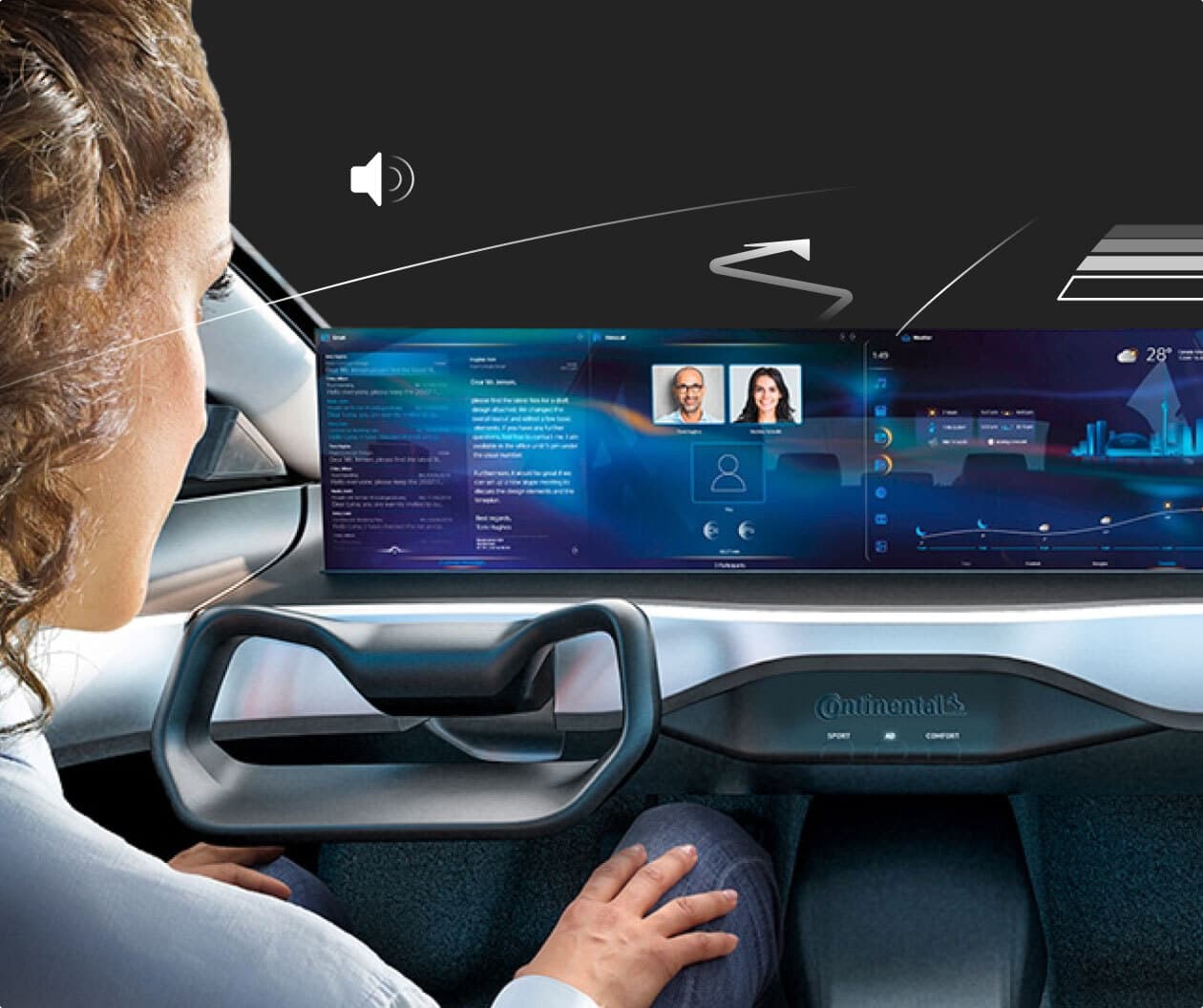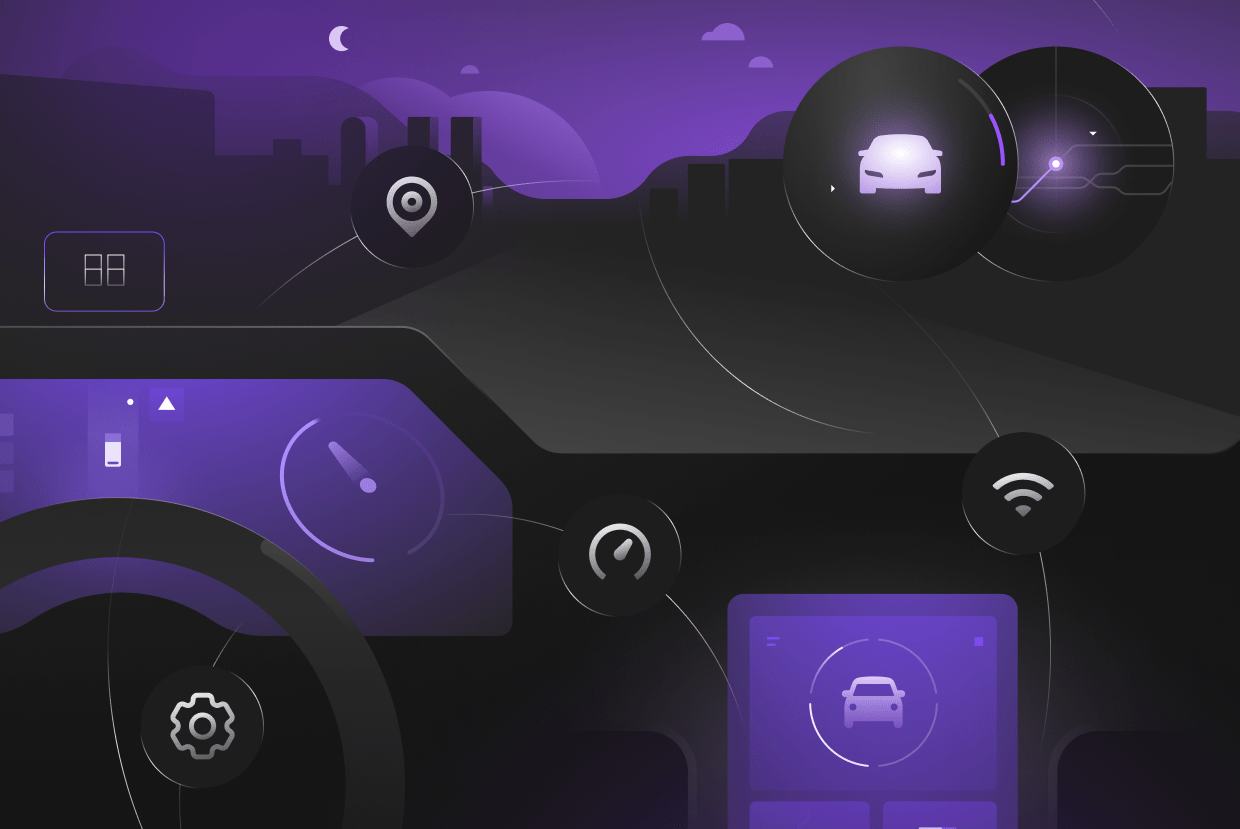Consumers expect more from their vehicles than ever before. No longer simply methods of getting from A to B, cars have become mobile entertainment hubs that double as digital cockpits. Many drivers — particularly younger generations and parents — care more about in-car interfaces than leather stitching or horsepower. They want a vehicle that improves their life and supports the mobile applications they can’t live without.
Automotive HMI design is the core features and components of car hardware and software applications that allow drivers and passengers to engage with the vehicle, as well as the outside world.
These solutions include navigation system touchscreens, voice-enabled vehicle infotainment, the steering wheel, buttons, heads-up displays and driving assistance tools that enable people to understand in-car technology, operate their vehicles safely and feel comfortable and in-control as self-driving becomes more widely available.
But as with any solution out there, automotive HMI design comes with many core challenges for OEMs. Here’s how they can solve them and delight their customers today.
Challenge: what do drivers want from automotive HMI design?
Audiences have incredibly high expectations and automotive brands need creative HMI design that’s good enough to compete with mobile devices. The best vehicle HMI is user-centric. You can’t create that unless you understand the driver, as well as the passenger. OEM innovation and R&D teams conduct primary research in-field, but it’s intended to qualify small tech opportunities before beginning production.
Most OEMs are not doing a good enough job understanding their audience, at scale, when designing HMI. Instead, they rely on sometimes outdated market research and consumer segments they get second-hand from marketing teams.
But drivers have expectations and priorities that may actually surprise you. Some care most about streaming their favorite music, connecting seamlessly with productivity applications and voice assistants or keeping their kids engaged on long trips. Others just want human-machine interaction to be as safe and simple as possible, with no distractions or automation.
Solution
To understand different customer journeys and need states, automotive brands have to connect directly with consumers and refine their in-car software product continuously — and quickly. They should conduct qualitative customer research to understand their buyer and establish systems for testing features with real drivers and updating continually based on data and user feedback. Basically, they need to approach testing like a consumer-first software product company.
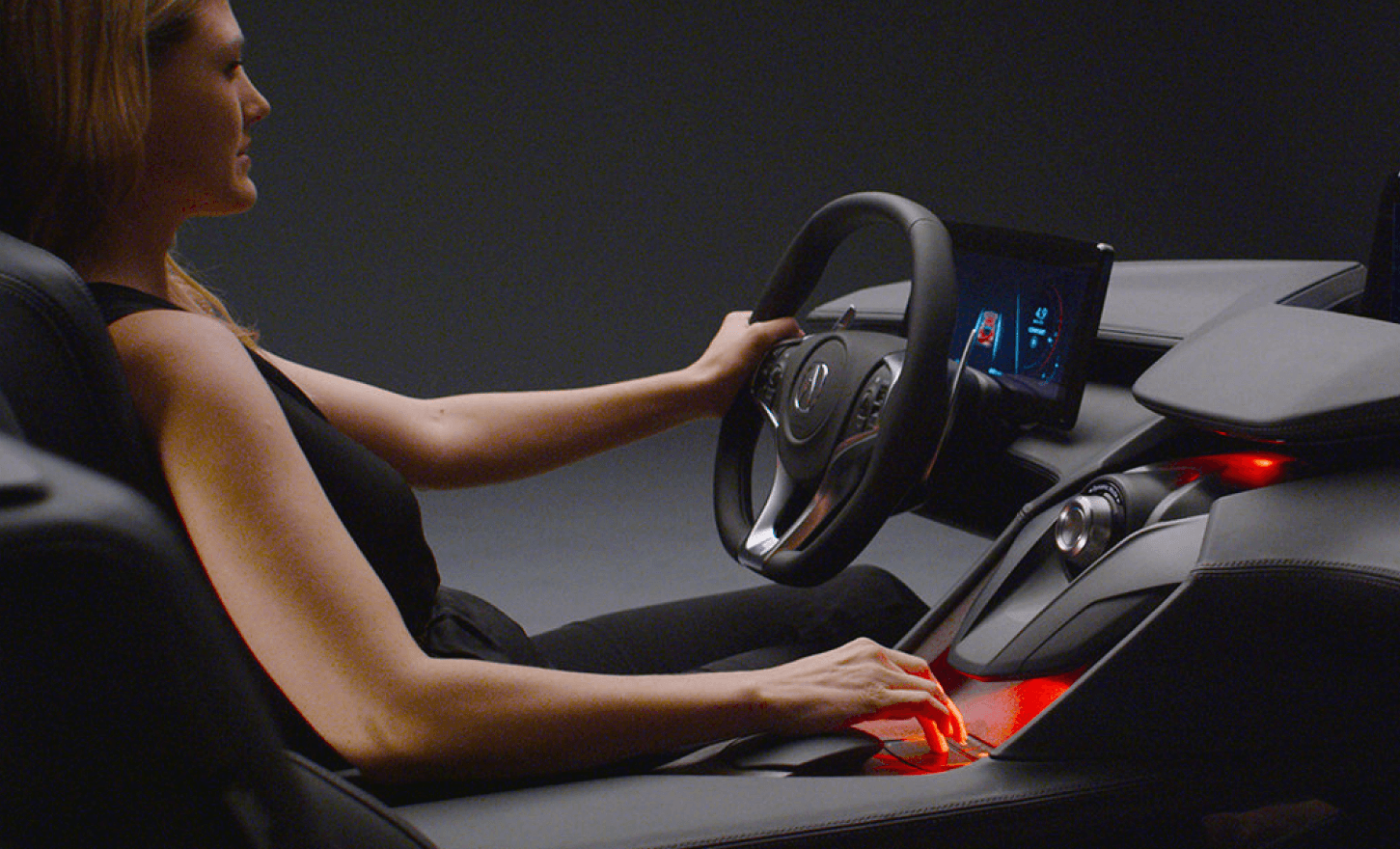
Additionally, they must understand macro trends affecting the vehicle HMI space, such as the rise of shared ownership and the future of voice.
Challenge: How to design HMI for a software-defined vehicle
Software-defined vehicles (SDVs) have fundamentally altered HMI expectations. Instead of shipping a static interface, manufacturers now have to create a flexible, centralized and upgradable UI layer capable of supporting constant evolution. This brings complexity too — interfaces have to adapt to different hardware configurations, screen sizes, feature sets and even regional regulations over the product lifecycle.
Solution
A platform-based design system allows teams to build modular components that scale across multiple models, trims and regions while maintaining consistency. The system should include reusable UI elements, motion patterns, voice interaction guidelines and multi-modal rules.
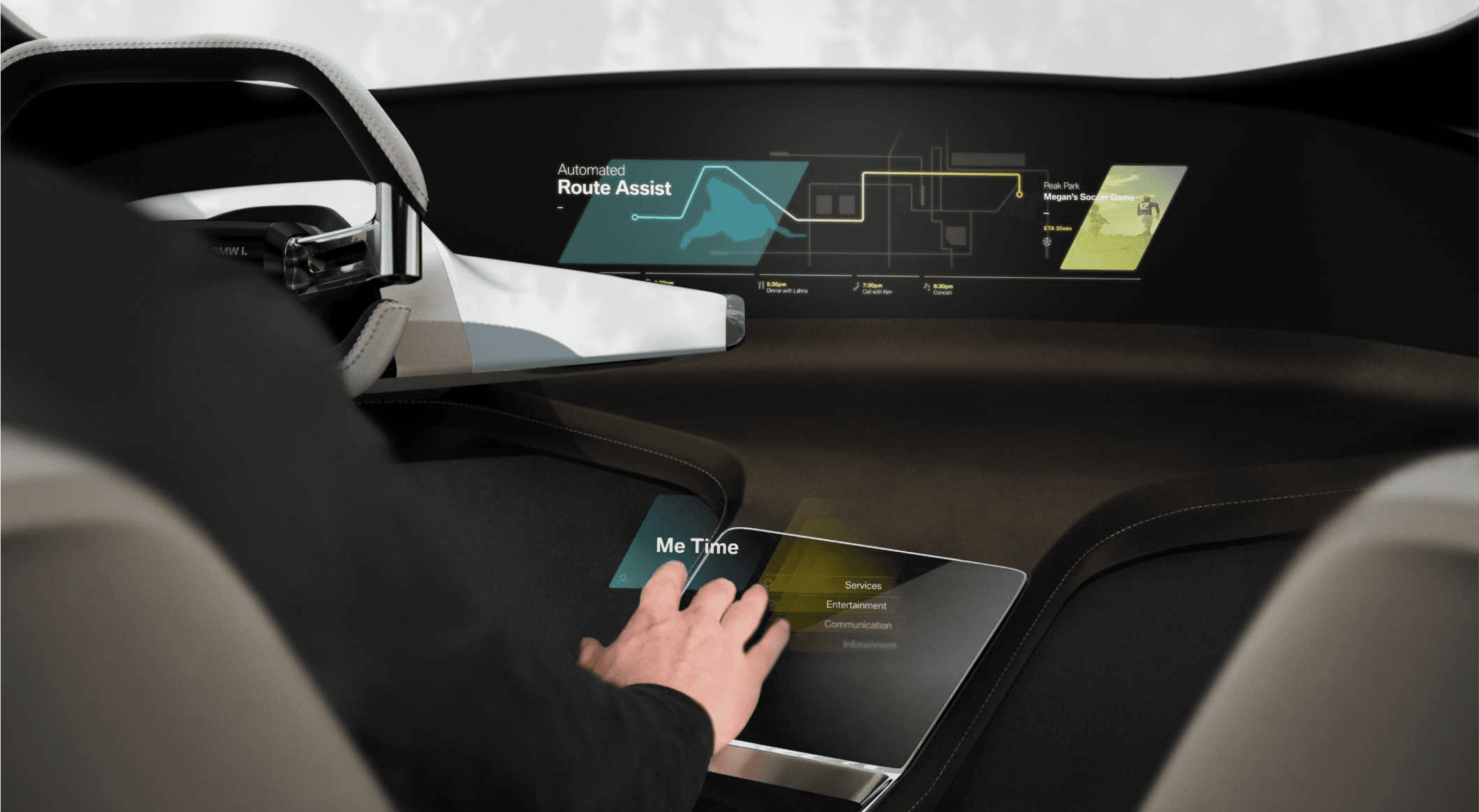
OEMs should design flows with the assumption that features will change post-launch, therefore screens must be adaptable. Early collaboration between UX, HMI engineering and platform teams ensures that design concepts fit within real SDV constraints such as system architecture, performance budgets, boot-up sequences and memory limitations.
Virtual automotive prototyping with real-time simulation tools helps validate the user experience early before committing to physical hardware.
Challenge: How to integrate AI into HMI design
AI-powered cabin assistants have moved from novelty to expectation. Drivers now want natural conversations, proactive suggestions and the ability to control nearly all vehicle functions via voice. However, poorly designed AI interactions can create uncertainty, overpromising or unpredictable behavior that undermines trust.
Solution
AI must be transparent. Designers should clearly communicate what the assistant can do, what it cannot do and why. Multi-step tasks — like planning a multi-stop EV charging route or setting up a driver profile — should be voice-led, with the system assisting through generative reasoning when appropriate. But in all cases, AI responses should remain predictable, concise and safe for in-motion use.
To improve trust, interfaces should provide feedback cues to show when the AI is listening, processing or confirming. Privacy settings should be obvious and easily accessible, with clear consent prompts for data-driven personalization.
Challenge: How to localize automotive HMI design
Driving habits, technological expectations and regulatory requirements vary dramatically between regions. An interface loved by Chinese drivers may feel overwhelming in Europe like Germany, while a feature-rich display expected in Japan may appear excessive in North America.
Regulatory differences also affect HMI components like color usage, ADAS messaging, icon standards and voice assistant capabilities.
Solution
OEMs need to consider regional differences as they expand into new markets. Automotive UX teams should conduct targeted and ongoing regional research to understand local preferences and cultural patterns rather than relying on outdated global averages. This includes studying navigation behavior, climate control expectations, menu depth tolerance and even symbolic interpretation of color.
Interfaces also need to support flexible localization, not just literal translation. This includes region-specific home screens, app ecosystems, content services and available features. Even driving modes or ADAS settings often require market-based adjustments.
When we partnered with SAIC to create HMI design solutions for a new line of electric vehicles targeting drivers in India and Thailand, we embraced technology trends like connectivity, voice and other digital touch points.

We knew the target audience would appreciate next-gen features and special effects that might not have mattered as much in other markets.
Ready to learn more about Star’s award-winning design and development solutions?
Challenge: What does personalization mean in HMI design?
Personalization has become one of the strongest expectations in modern automotive HMIs. Drivers increasingly expect their vehicles to behave like adaptive digital products that reflect their individualism — remembering preferences, anticipating needs and customizing the interface automatically.
But personalization at scale is complex. Vehicles often have multiple drivers, conflicting preferences and different comfort levels with data-driven features. Also overly aggressive personalization can feel intrusive, while too much manual configuration can overwhelm users.
Solution
Effective personalization begins with intelligent, non-intrusive defaults. The system should learn from user behavior — preferred climate settings, common navigation routes, seating positions, favorite apps — and gently adapt over time without interrupting the experience.
Profiles should also sync seamlessly across the entire ecosystem: companion mobile apps, cloud services, shared vehicles and different user accounts. That way, users have consistency regardless of which vehicle or device the driver is using — something users demand. Automotive HMI personalization can take many forms:
- Adaptive UI layout that surfaces frequently used features
- Dynamic themes that adjust to time of day, driving mode or mood
- Context-aware suggestions like pre-conditioning before charging or route guidance based on routine
- Voice assistant familiarity with user phrasing, habits or regional speech patterns
- Predictive EV energy management based on driving style and past behavior
To maintain trust, make personalization settings transparent and easy to manage. Users should always know why a recommendation appears, how to adjust it or how to reset learned behavior. When done well, personalization transforms the vehicle from a static interface into a context-aware, intelligent companion that increases comfort and builds emotional connections.
Challenge: How to integrate connected car & smartphone ecosystems
Modern vehicles exist within a broader digital ecosystem that spans smartphones, cloud services, home devices, charging networks and mobility platforms. Drivers now expect seamless continuity within this ecosystem. Routes started on a phone should appear instantly in the vehicle, climate presets should synchronize across devices and remote features should be as simple as using any other app.
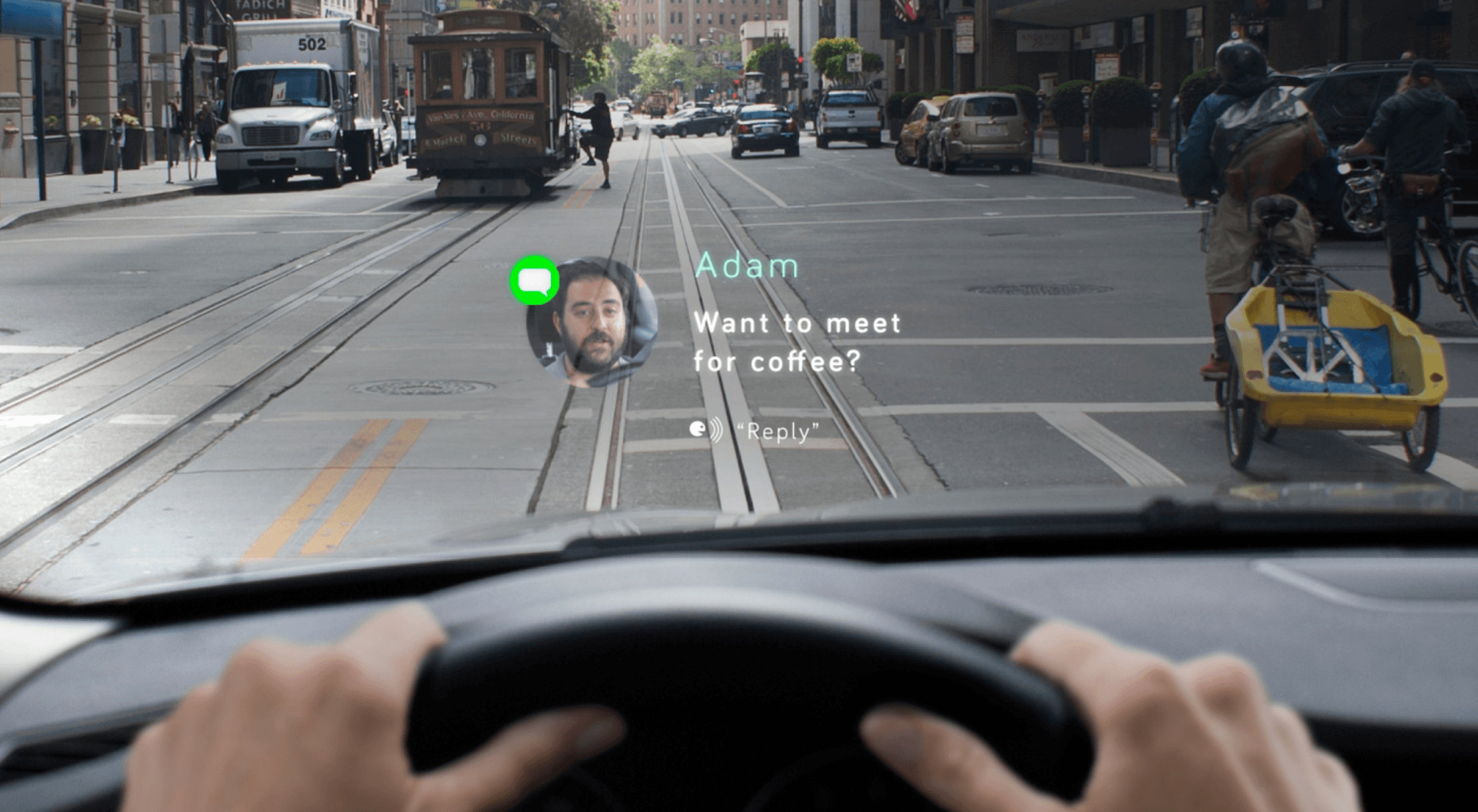
Yet achieving this integration is technically and strategically complex. Navigating fragmented mobile platforms, varying levels of connectivity, stringent data privacy rules and the growing influence of third-party ecosystems like CarPlay, Android Auto and digital assistants are all challenges OEMs have to navigate.
Without a clear strategy, the in-vehicle experience can feel inconsistent or overshadowed by external platforms.
Solution
A successful integrated ecosystem positions the vehicle as the central, trusted interface for mobility. Smartphones and cloud services work in tandem to enhance convenience, setup and personalization. Key design principles include:
- Streamlined onboarding and setup: Use the mobile app for profile creation, vehicle pairing, digital key activation and importing preferences before the first drive
- Cross-device continuity: Support seamless handoff of navigation, media, calendars and charging plans between phone and vehicle, reducing friction during routine usage
- Balanced integration with CarPlay and Android Auto: Allow choice and convenience while ensuring safety-critical features — ADAS, HVAC, energy management, automation states — remain anchored in the native HMI design
- Intelligent voice ecosystem management: Enable multiple assistants when appropriate but define consistent behavior for in-car tasks so users never receive conflicting guidance
- Cloud-synchronized personalization: Profiles, themes, usage history and vehicle behaviors should follow the user across multiple vehicles through secure cloud identity
- Robust API and services layer: Provide a secure foundation for third-party services — charging, parking, navigation, mobility apps — to integrate without compromising performance, privacy or brand identity
When executed well, ecosystem integration transforms the vehicle from a standalone product into an adaptive, connected mobility platform, giving drivers fluid transitions across their digital life while preserving the OEM’s unique brand experience.
Challenge: How do I ensure safety with higher levels of automation?
Thanks to the the rise of autonomous driving technologies, in-cabin monitoring is on the rise. Level 2+ and Level 3 automated driving systems introduce new HMI complexity: interface must constantly communicate the system’s status, capabilities and limitations in a clear and trustworthy way. Miscommunication or delayed feedback can lead to confusion and unsafe handover scenarios between the vehicle and the driver.
Solution
Designers should create a consistent visual language for automation states: available, active, limited or requiring driver intervention. This can include color-coded clusters, animations that clarify transitions and HUD indications that remain visible without blocking the road view. Multi-modal, in-cabin alerts — haptic steering wheel pulses, audible chimes, seat vibrations or ambient lighting — allow drivers to receive urgent messages even if they miss visual cues.
HMI should also integrate with driver monitoring systems to detect inattention and adapt prompts accordingly. Knowing if a driver is alert enough to take back control is essential. Drivers must always understand when it’s their turn to take control and how urgently they must act.
In-cabin monitoring provides new opportunities. For example, Tesla's "Dog mode" keeps pets comfortable when left in the car, highlighting how in-vehicle sensors can do more than just improve your own safety.

Automotive HMI design tips and principles
Quality HMI can make a car feel nearly magical by using data, technology and intuitive HMI design to create perfectly-timed experiences. It's challenging but automotive HMI is honestly an interface designer’s dream. Every automotive HMI project is different, but here’s a look at design principles and trends that guide our work at Star:

- Safety trumps everything. Consider safety at every moment of the experience you are designing. Safety best practices for in-vehicle UX include:
- Deliver minimal and relevant information to the user at the right moment, because the human brain cannot process too much information at one time
- Ensure high readability (contrast + dimensions + font) and use pictograms rather than images.
- Try new ways of receiving information with senses beyond sight, such as sound and haptic input, which are easier to process in complex situations
- Remember the human at the center. Understand the countless use cases drivers encounter and the customer journeys that go with them. Design HMI to complement different user needs and driving experiences, as well as different contexts and situations. Don’t forget vehicle HMI needs to be easy to use and support basic needs, as well as high-tech demands
- Get the hardware right. HMI solutions include heads-up display (HUD), rear-seat entertainment systems, steering-based controls, instrument clusters and voice assistant interfaces. Choosing the right displays, screens, processing power and conductivity lays the groundwork for the software-based use cases you need to build in-vehicle UX that delights drivers
- Move quickly, test and iterate. You’ll learn a lot by watching people engage with your interface. Test prototypes early, consult with your technology and development team throughout the process, keep an open mind and remember the space is dynamic. New features appear daily, creating new possibilities to delight drivers, so the improvement process is really never done
- Details and craftsmanship matter. OEMs put a lot of work into building a vehicle that feels right. In-car interfaces need to be just as good. This means deploying the appropriate technology to support needed tools and functions, but also designing the HMI in a way that is inspired by the vehicle so in-car interfaces feel organic and the entire driving experience seems holistic
- Think beyond the speedometer. View the collection of screens and sensors as a blank canvas. Resist the temptation to recreate traditional car displays, for example, by creating a digital copy of an old-school speedometer. Innovative brands are thinking bigger, creating experiences that can’t be recreated in the physical world using animation and haptic feedback
- Think conversation, not just automation. Consider how consumers interact with Alexa, Google Home and Siri. They say what they want. Technology answers. Agentic HMI features empower users with tools and information
Now it's time to put design into practice. Learn the ins and outs of HMI development and see next-gen trends in our new article and guide: The future of automotive development.

